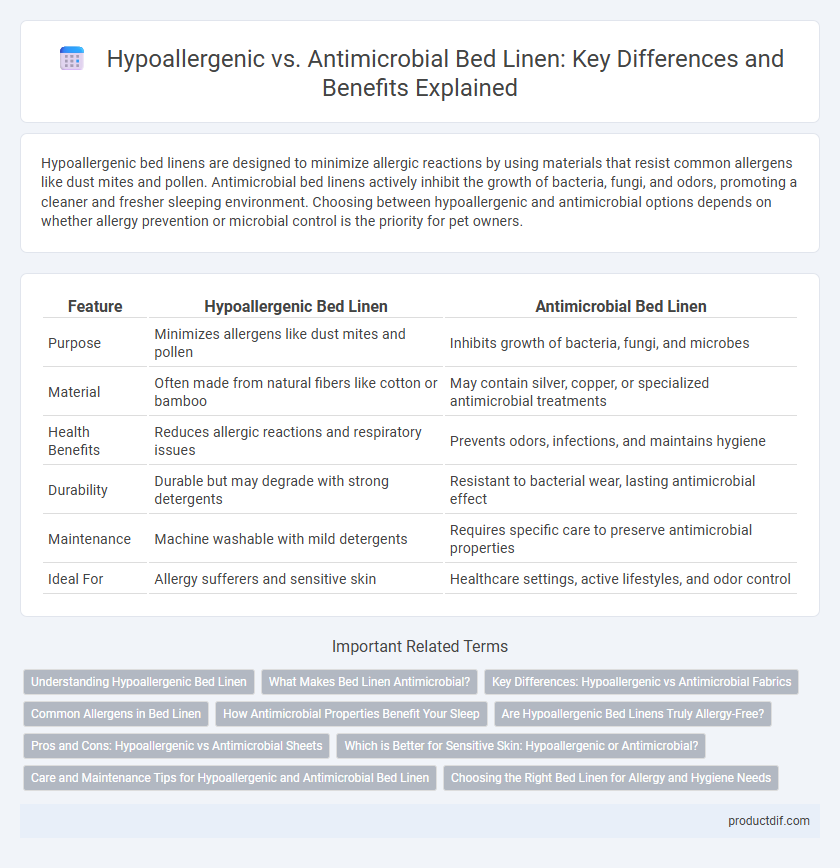Hypoallergenic bed linens are designed to minimize allergic reactions by using materials that resist common allergens like dust mites and pollen. Antimicrobial bed linens actively inhibit the growth of bacteria, fungi, and odors, promoting a cleaner and fresher sleeping environment. Choosing between hypoallergenic and antimicrobial options depends on whether allergy prevention or microbial control is the priority for pet owners.
Table of Comparison
| Feature | Hypoallergenic Bed Linen | Antimicrobial Bed Linen |
|---|---|---|
| Purpose | Minimizes allergens like dust mites and pollen | Inhibits growth of bacteria, fungi, and microbes |
| Material | Often made from natural fibers like cotton or bamboo | May contain silver, copper, or specialized antimicrobial treatments |
| Health Benefits | Reduces allergic reactions and respiratory issues | Prevents odors, infections, and maintains hygiene |
| Durability | Durable but may degrade with strong detergents | Resistant to bacterial wear, lasting antimicrobial effect |
| Maintenance | Machine washable with mild detergents | Requires specific care to preserve antimicrobial properties |
| Ideal For | Allergy sufferers and sensitive skin | Healthcare settings, active lifestyles, and odor control |
Understanding Hypoallergenic Bed Linen
Hypoallergenic bed linen is designed to reduce the risk of allergic reactions by using materials that resist common allergens such as dust mites, pet dander, and mold. These linens often feature tightly woven fabrics made from organic cotton, bamboo, or microfiber, which create a barrier against allergens while maintaining breathability and comfort. Understanding the distinction from antimicrobial properties, which focus on inhibiting bacterial growth, is essential for choosing bed linen tailored to specific health needs and sensitivities.
What Makes Bed Linen Antimicrobial?
Bed linen becomes antimicrobial through the integration of specialized agents such as silver ions, copper, or natural extracts that inhibit the growth of bacteria, fungi, and mold on fabric surfaces. These antimicrobial treatments prevent odors and prolong fabric freshness by disrupting microbial cell functions, ensuring a cleaner and healthier sleeping environment. Unlike hypoallergenic linens designed to minimize allergens, antimicrobial bed linens actively combat microbial contamination, enhancing hygiene and durability.
Key Differences: Hypoallergenic vs Antimicrobial Fabrics
Hypoallergenic bed linens are designed to minimize allergic reactions by using tightly woven fabrics that reduce dust mite and pollen penetration, whereas antimicrobial fabrics inhibit the growth of bacteria, mold, and fungi to maintain freshness and hygiene. Hypoallergenic materials often include cotton, silk, and bamboo, known for their natural resistance to allergens, while antimicrobial fabrics typically feature silver, copper, or specialized chemical treatments embedded in the textile. The primary difference lies in hypoallergenic fabrics focusing on allergy prevention, while antimicrobial bed linens target microbial contamination and odor control.
Common Allergens in Bed Linen
Hypoallergenic bed linen is designed to minimize common allergens such as dust mites, pet dander, and pollen, reducing the risk of allergic reactions for sensitive sleepers. Antimicrobial bed linen inhibits the growth of bacteria, fungi, and mold that can exacerbate allergies and cause unpleasant odors. Choosing bed linen with both hypoallergenic and antimicrobial properties provides enhanced protection against common allergens and improves overall sleep hygiene.
How Antimicrobial Properties Benefit Your Sleep
Antimicrobial bed linen inhibits the growth of bacteria, fungi, and other microbes, reducing odors and skin irritations to promote a cleaner sleep environment. Unlike hypoallergenic fabrics that primarily prevent allergens, antimicrobial properties actively protect against harmful microorganisms, enhancing overall sleep quality. This protection helps maintain freshness and extends the lifespan of your sheets, contributing to healthier, more restful nights.
Are Hypoallergenic Bed Linens Truly Allergy-Free?
Hypoallergenic bed linens are designed to minimize allergens like dust mites, pet dander, and pollen, but they are not completely allergy-free as individual sensitivities vary. Antimicrobial bed linens offer enhanced protection by inhibiting the growth of bacteria, mold, and fungi, which can exacerbate allergic reactions or skin irritations. Choosing bedding with both hypoallergenic and antimicrobial properties provides a comprehensive approach to reducing allergens and maintaining a healthier sleeping environment.
Pros and Cons: Hypoallergenic vs Antimicrobial Sheets
Hypoallergenic sheets reduce allergic reactions by using materials that minimize dust mites and allergens, making them ideal for sensitive skin but may lack protection against bacteria and odors. Antimicrobial sheets inhibit the growth of bacteria and fungi, enhancing hygiene and odor control but can sometimes contain chemicals that may irritate sensitive users or cause environmental concerns. Choosing between hypoallergenic and antimicrobial sheets depends on prioritizing allergy prevention or microbial protection based on individual health needs.
Which is Better for Sensitive Skin: Hypoallergenic or Antimicrobial?
Hypoallergenic bed linen is specifically designed to minimize allergens such as dust mites, pollen, and pet dander, making it ideal for sensitive skin prone to irritation and allergic reactions. Antimicrobial bed linen, treated with agents that inhibit the growth of bacteria and fungi, helps reduce odors and potential infections but may contain chemicals that could irritate very sensitive skin. For individuals with sensitive skin, hypoallergenic bedding is generally the better choice as it focuses on preventing allergen exposure without the risk of chemical irritation.
Care and Maintenance Tips for Hypoallergenic and Antimicrobial Bed Linen
Hypoallergenic bed linen requires frequent washing in hot water above 130degF to remove dust mites and allergens effectively, while using mild, fragrance-free detergents to maintain fabric integrity. Antimicrobial bed linen benefits from regular cleaning to prevent microbial growth, but avoid bleach and fabric softeners that can degrade antimicrobial treatments. Both types should be dried thoroughly in direct sunlight or a high-heat dryer to enhance their protective properties and ensure hygiene.
Choosing the Right Bed Linen for Allergy and Hygiene Needs
Hypoallergenic bed linen is designed to minimize allergic reactions by using materials that resist dust mites, mold, and pet dander, making it ideal for sensitive skin and allergy sufferers. Antimicrobial bed linen incorporates treatments or fibers that actively inhibit the growth of bacteria, fungi, and odors, enhancing hygiene and freshness. Selecting the right bed linen depends on individual allergy sensitivities and hygiene preferences, ensuring both comfort and protection during sleep.
Hypoallergenic vs Antimicrobial Infographic

 productdif.com
productdif.com